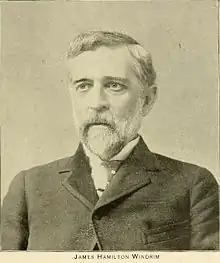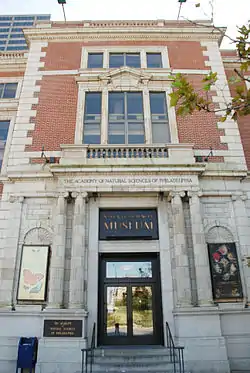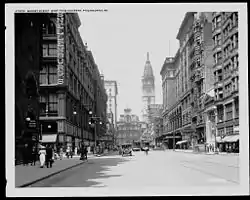James Hamilton Windrim | |
|---|---|
 | |
| Born | January 4, 1840 |
| Died | April 26, 1919 (aged 79) Philadelphia, Pennsylvania, U.S. |
| Resting place | West Laurel Hill Cemetery, Bala Cynwyd, Pennsylvania, U.S. |
| Citizenship | United States |
| Alma mater | Girard College |
| Occupation | architect |
| Spouse | Mary Barr McCutcheon Windrim |
| Children | John T. Windrim, James Hamilton Windrim, Jr., Elizabeth Windrim Flagg |
| Buildings | Masonic Temple (Philadelphia), U.S. Treasury (Philadelphia), National Savings and Trust Company (Washington, DC) |
James Hamilton Windrim (January 4, 1840 – April 26, 1919) was a Philadelphia architect who specialized in public buildings, including the Masonic Temple in Philadelphia and the U.S. Treasury.[1] A number the buildings he designed are on the National Historic Landmarks and/or the National Register of Historic Places, including the Masonic Temple in Philadelphia and the National Savings and Trust Company building in Washington, DC.
Early life and education

Born in Philadelphia, he apprenticed under John Notman.
Career
In 1867, he opened his own firm. That same year, at age 27, he won the design competition for the Philadelphia Masonic Temple, the building for which he is best remembered.
In 1871, he was named architect for the Stephen Girard Estate, designing several buildings at Girard College and a complex of stores on Market Street that became Snellenburg's Department Store.
As supervising architect for the U.S. Treasury Department in Washington, D.C. from 1889 toi 1891, he was responsible for all U.S. federal government construction. He designed at least 16 federal buildings across the country that consolidated post offices, federal offices, and federal courts. He then returned to his native Philadelphia, where he served as director of public works for the City of Philadelphia from 1891 to 1895.
He served as president of the Philadelphia Chapter of the American Institute of Architects from 1879 to 1886. His son, John T. Windrim, joined his architectural firm, James H. Windrim & Son, in 1882, and took over after his retirement.
Windrim designed the Smith Memorial Arch in West Fairmount Park in Philadelphia, one of the nation's largest public parks. The arch features a bronze bust of him developed by sculptor Samuel Murray.
Death
Windrim died in Philadelphia on April 26, 1919, at age 79.
Selected works
Philadelphia buildings

- Philadelphia Masonic Temple, NE corner Broad & Filbert Streets (1868–73).[2]
- Academy of Natural Sciences, 1900 Logan Square (now Logan Circle) (1868–72).
- Kemble-Bergdoll Mansion, 2201-05 Green Street, (ca. 1885).[3] Windrim added the carriage house in 1889.
- Falls Bridge over Schuylkill River, Fairmount Park (1894–95), with George S. Webster, chief engineer, City of Philadelphia.[4]
- Smith Memorial Playground & Playhouse, Reservoir Drive, East Fairmount Park (1898–99).[5]
- Smith Memorial Arch (Civil War Memorial), South Concourse & Lansdowne Drive, West Fairmount Park (1898–1912), with John T. Windrim.[6]
- North American Building, 121 South Broad Street (1900). This was the tallest building in Philadelphia for about a year, until the 1901 completion of City Hall Tower. Commonwealth Title & Trust Company Building, 1201-05 Chestnut Street (1901–06), with John T. Windrim.[7]
- Main Building, Thomas Jefferson University Hospital, 132 South 10th Street (1903).
- Lafayette Building, NE corner Fifth & Chestnut Streets (1907–08), with John T. Windrim.[8]
Demolished Philadelphia buildings
- Philadelphia Trust, Safe Deposit and Insurance Company, 415 Chestnut Street (1873–74, demolished 1959).[9]
- Agricultural Hall, Centennial Exposition, West Fairmount Park (1875–76, demolished).
- Snellenberg's Department Store, 1100-42 Market Street (1886–87, remodeled and upper floors demolished 1960s, remainder demolished 2015).[10] Built by the Stephen Girard Estate.
- Western Saving Fund Society, 1000-08 Walnut Street (ca. 1887, demolished 1967).[11]
- Bank of North America, 305-07 Chestnut Street (1893–95, demolished 1972), with John T. Windrim.[12]
Buildings elsewhere
- National Saving And Trust Company, New York Avenue & Fifteenth Street NW, Washington, D.C. (1888).
- U.S. Post Office and Courthouse (now Paul Laxalt State Building), 401 Carson Street, Carson City, Nevada (1888–91), designed by Mifflin E. Bell, completed by Windrim.[13]
- Altoona Masonic Temple, 1111-19 Eleventh Street, Altoona, Pennsylvania (1889–90).[14]
- U.S. Post Office and Courthouse (now Abingdon Police Department), 425 West Main Street, Abingdon, Virginia (1889–90), with Will A. Freret.[15]
- U.S. Post Office and Courthouse (now Lancaster Municipal Building), 120 North Duke Street, Lancaster, Pennsylvania (1889–92).[16]
- U.S. Post Office and Courthouse (now Mississippi River Commission Building), 1400 Walnut Street, Vicksburg, Mississippi (1890–92).
- U.S. Post Office and Courthouse, Scranton, Pennsylvania (1890–94, demolished 1930).
- U.S. Post Office and Courthouse (Detroit Federal Building), Shelby & Fort Streets, Detroit, Michigan (1890–97, demolished 1931).[17]
- U.S. Post Office and Courthouse (now Springfield City Hall), 830 Boonville Avenue, Springfield, Missouri (1891–94), with Willoughby J. Edbrooke.[18]
- U.S. Post Office and Courthouse, Sacramento, California (1891–94, demolished 1966).[19]
- United States Government Building for Columbian Exposition, Jackson Park, Chicago, Illinois, 1893, Ralph, Julian; Chicago and the World’s Fair Harper & Brothers, 1892, New York p238
 Interior of Philadelphia Masonic Temple (1868–73).
Interior of Philadelphia Masonic Temple (1868–73). Academy of Natural Sciences, Philadelphia, PA (1868–72).
Academy of Natural Sciences, Philadelphia, PA (1868–72). Agricultural Hall, Centennial Exposition, Philadelphia, PA (1875–76, demolished).
Agricultural Hall, Centennial Exposition, Philadelphia, PA (1875–76, demolished)..jpg.webp) Kemble-Bergdol Mansion, 2201-05 Green St., Philadelphia, PA (ca. 1885).
Kemble-Bergdol Mansion, 2201-05 Green St., Philadelphia, PA (ca. 1885). Snellenburg's Department Store, Philadelphia, PA (1886–87, demolished), in a circa 1915 photograph.
Snellenburg's Department Store, Philadelphia, PA (1886–87, demolished), in a circa 1915 photograph..jpg.webp) Western Saving Fund Society, Philadelphia, PA (ca. 1887, demolished 1967), before 1910 expansion.
Western Saving Fund Society, Philadelphia, PA (ca. 1887, demolished 1967), before 1910 expansion..jpg.webp) U.S. Post Office and Courthouse (now Lancaster Municipal Building), Lancaster, PA (1889–92).
U.S. Post Office and Courthouse (now Lancaster Municipal Building), Lancaster, PA (1889–92). U.S. Post Office and Courthouse (now Mississippi River Commission Building), Vicksburg, MS (1890–92).
U.S. Post Office and Courthouse (now Mississippi River Commission Building), Vicksburg, MS (1890–92). U.S. Post Office and Courthouse, Scranton, PA (1890–94, demolished 1930).
U.S. Post Office and Courthouse, Scranton, PA (1890–94, demolished 1930). U.S. Post Office and Courthouse (Detroit Federal Building), Detroit, Michigan (1890–97, demolished 1931).
U.S. Post Office and Courthouse (Detroit Federal Building), Detroit, Michigan (1890–97, demolished 1931). Smith Memorial Playground & Playhouse, Philadelphia, PA (1898–99).
Smith Memorial Playground & Playhouse, Philadelphia, PA (1898–99)..jpg.webp) Smith Memorial Arch (Civil War Memorial), Philadelphia, PA (1898-1912).
Smith Memorial Arch (Civil War Memorial), Philadelphia, PA (1898-1912).
References
- ↑ "James Hamilton Windrim letterpress book". Historical Society of Pennsylvania. Retrieved 2022-11-22.
- ↑ Philadelphia Masonic Temple from HABS.
- ↑ Kemble-Bergdoll Mansion from Flickr.
- ↑ Falls Bridge from HABS.
- ↑ Smith Memorial Playground
- ↑ Smith Memorial Arch from HABS.
- ↑ Commonwealth Title Building from Flickr.
- ↑ Lafayette Building with proposed glass tower from "Changing Skyline," Philadelphia Inquirer.
- ↑ Philadelphia Trust from HABS.
- ↑ Snellenberg's from Bryn Mawr College.
- ↑ Western Saving Fund from HABS.
- ↑ Bank of North America from HABS.
- ↑ Carson City Post Office and Courthouse from HABS.
- ↑ Altoona Masonic Temple from HABS.
- ↑ Abingdon Post Office and Courthouse from Federal Judicial Center.
- ↑ Lancaster Post Office and Courthouse from HABS.
- ↑ Detroit Federal Building Archived 2010-02-27 at the Wayback Machine from Buildings of Detroit.
- ↑ Springfield City Hall from Flickr.
- ↑ Sacramento Post Office and Courthouse from Western Legal History.
External links
- Works by or about James H. Windrim at Internet Archive
- James H. Windrim from Philadelphia Architects and Buildings.
- James H. Windrim at Find a Grave